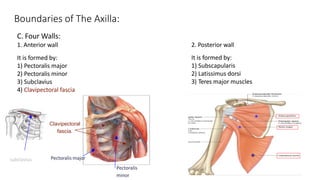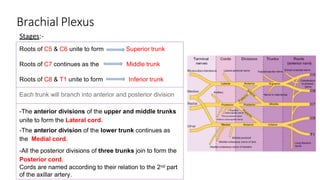6-Pectoral Region and Axilla pdf.pptx hj
- 1. Objectives Identify and describe the muscles of the pectoral region. I. Pectoralis major. II. Pectoralis minor. III. Subclavius. IV. Serratus anterior. Describe and demonstrate the boundaries and contents of the axilla. Describe the formation of the brachial plexus and its branches.
- 2. The movements of the upper limb Note: differentiate between the differentregions Flexion & extension of wrist = hand Flexion & extension of shoulder = arm = humerus Flexion & extension of elbow = forearm
- 3. I. Pectoralis Major Origin 2 heads Clavicular head: From Medial ½ of the front of the clavicle. Sternocostal head: From; Sternum. Upper 6 costal cartilages. Aponeurosis of the external oblique muscle. Insertion Lateral lip of bicipital groove (humerus)* Nerve Supply Medial & lateral pectoral nerves. Action Adduction and medial rotation of the arm. Only the clavicular head helps in flexion of arm (shoulder). Recall what we took in foundation: Muscles are attached to bones / ligaments / cartilage by 1) tendons 2) aponeurosis 3) raphe Extra picture for understanding Costal cartilage (hyaline cartilage that connects the ribs to the sternum) * 3 muscles are attached at the bicipital groove: Latissimus dorsi, pectoral major, teres major Extra
- 4. II. Pectoralis Minor 3 4 5 Origin From 3rd ,4th, & 5th ribs close to their costal cartilages. Insertion Coracoid process (scapula)* Nerve Supply Medial pectoral nerve. Action 1. Depression of the shoulder. 2. Draw the ribs upward and outwards during deep inspiration. *Don’t confuse the coracoid process on the scapula with the coronoid process on the ulna Extra
- 5. III. Subclavius Origin From 1st rib at its junction with the 1st costal cartilage Insertion Subclavian groove in the middle 1/3 of the inferior surface of clavicle. Nerve Supply Nerve to subclavius from upper trunk of brachial plexus Action Fixes the clavicle during movement of shoulder joint. (pulls the clavicle medially to stablize sternoclavicular joint)
- 6. Clavipectoral Fascia o It is thickened membrane of deep fascia* (between subclavius & pectoralis minor). o It is pierced (ث ق و ب م ) by : 1- Lateral pectoral nerve. 2- Thoraco-acromial artery. 3 Cephalic vein. 4 Few lymph vessels. *(fascia = connective tissue) Extrapicture for understanding
- 7. Origin Upper eight ribs. Insertion anterior aspect of the medial border and inferior angle of scapula (the blue part). Nerve Supply Long thoracic nerve (from roots of brachial plexus,C5,6,7). (also called nerve of Bell / nerve to serratus anterior) 1. Draws the scapula forward in boxing (protrusion or protraction)*. "boxer's muscle" 2. Rotates scapula outwards in raising the arm above 90 degree (Abduction above 90) with trapezius. Action IV. Serratus anterior *Don’t confuse protraction and retraction. Retraction (when you wake up and are yawning) Protraction (when you extend your arm like when punching someone or boxing hence the name boxers muscle)
- 8. Causes of Winging of Scapula: 1) Dislocation of shoulder joint. 2)Lesion of long thoracic nerve and paralysis of Serratus anterior muscle (The long thoracic nerve runs on the anterolateral chest wall usually. It is damaged in radical mastectomy operations or injury of chest wall). Radical mastectomy is a surgical procedure in which the breast, underlying chest muscle, and lymph nodes of the axilla are removed as a treatment for breast cancer.
- 9. Axilla o A pyramid-shaped space between the upper part of the arm and the side of the chest ( ا إل ب ط ن ط ق ة م) o It’s the space through which major neurovascular structures pass between neck & thorax and upper limbs. The Axilla has: A. Apex B. Base C. Four Walls: 1.Anterior, 2.Posterior, 3.Medial, 4.Lateral wall Extra picture for understanding
- 10. Boundaries of The Axilla: A. Apex: o It’s called Cervicoaxillary canal (through which the neurovascular structures pass) o It is directed upwards and medially into the root of the neck. o The Apex is bounded by 3 bones: 1. Clavicle anteriorly. 2. Upper border of the scapula posteriorly. 3. Outer border of the first rib medially. The picture in the previous slide shows the exact location of the apex (cervicoaxillary canal)
- 11. Boundaries of The Axilla: B. Base: o Formed by skin stretching between the anterior and posterior walls. o The base is bounded: 1. In front by the anterior axillary fold (formed by the lower border of the Pectoralis major). 2. Behind by the posterior axillary fold (formed by the tendons of latissimus dorsi and teres major muscles). 3. Medially by upper 4 or 5 ribs and the chest wall. Formed by 1 2
- 12. C. Four Walls: 1. Anterior wall It is formed by: 1) Pectoralis major 2) Pectoralis minor 3) Subclavius 4) Clavipectoral fascia Pectoralis minor Pectoralis major Clavipectoral fascia. subclavius Boundaries of The Axilla: 2. Posterior wall It is formed by: 1) Subscapularis 2) Latissimus dorsi 3) Teres major muscles
- 13. 4. Lateral wall It is formed by: 1) Coracobrachialis 2) Biceps brachii 3)Bicipital/ intertubercular groove of the humerus C. Four Walls: 3. Medial wall It is formed by: 1) Serratus anterior 2)Upper 4-5 ribs and intercostal muscle Boundaries of The Axilla:
- 14. Contents of The Axilla o Cords and branches of brachial plexus o Axillary artery and its branches o Axillary vein and its tributaries o Axillary lymph nodes o Axillary fat o Loose connective tissue The neurovascular bundle is enclosed in loose connective tissue sheath, called axillary sheath Extra picture for understanding
- 15. Brachial Plexus What is a brachial plexus? Brachial Plexus is a network of nerves that present at the root of the neck to enter the upper limb. Location & Formation: o It is present in the posterior triangle of the neck & axilla. o It is formed by the union of the anterior Rami of the C 5th, 6th, 7th, 8th, and the 1st thoracic spinal nerve. The posterior triangle consists of: 1) clavicle 2) sternocleidomastoid muscle 3) trapezius Remember in the spine we only have 7 cervical vertebra BUT there are 8 cervical spinal nerves.
- 16. Note: The first 2 stages lie in the posterior triangle, while the last 2 stages lie in the axilla. Brachial Plexus
- 17. Roots of C5 & C6 unite to form Superior trunk Roots of C7 continues as the Middle trunk Roots of C8 & T1 unite to form Inferior trunk Each trunk will branch into anterior and posterior division -The anterior divisions of the upper and middle trunks unite to form the Lateral cord. -The anterior division of the lower trunk continues as the Medial cord. -All the posterior divisions of three trunks join to form the Posterior cord. Cords are named according to their relation to the 2nd part of the axillar artery. Brachial Plexus Stages:-
- 18. Brachial Plexus The brachial plexus branches from the Cords Roots Trunks Lateral cord (3) Medial Cord (5) Posterior Cord (5) Dorsal scapular nerve (C5) Suprascapular nerve (C5,C6) Lateral pectoral nerve Medial pectoral nerve Axillary nerve. Long thoracic nerve To subclavius muscle (C5,C6) Musculocutaneous nerve Ulnar nerve Radial nerve Note: what is in the box memorized es should be Median nerve (lateral root). Median nerve (medial root) Upper & lower subscapular nerves Medial cutaneous nerve of arm & forearm Thoracodorsal or N. to latissimus dorsi Mnemonic (Team 433) Lateral Cord Branches: LLM "Lucy Loves Me“ Lateral pectoral, Lateral root of the median nerve, Musculocutaneous. Medial Cord Branches: MMUM "Most Men Use Morphine“ Medial pectoral, Medial cutaneous nerve of arm and forearm, Ulnar, Medial root of the median nerve. Posterior cord branches STAR Subscapular (upper and lower), Thoracodorsal, Axillary, Radial
- 19. Questions 1- Which of the following statements is NOT correct: A- The base of axilla is bounded posteriorly by the pectoralis major. B- The base of axilla is bounded medially by the 4 or 5th rib. C- The apex of the axilla is bounded by 3 bones (clavicle, scapula and the 1st rib). D- The apex is called cervicoaxillary canal. 2- The lateral wall of the axilla does not contain: A- biceps brachii B- upper 4-5 ribs and intercostal muscles C- bicipital groove of the humerus D- coracobrachialis 3- Which of the following is located between subclavius and pectoralis minor? A- Serratus anterior B- Axilla C- Clavipectoral Fascia D- Brachial Plexus 4- What is the nerve supply of Serratus anterior? A- Lateral pectoral nerve. B- Long thoracic nerve. C- Musculocutaneous nerve. D- Ulnar nerve. 5- Which wall is formed (partly) by the clavipectoral fasica? A- Anterior B- Posterior C- Medial D- Lateral 6- In the brachial plexus all the posterior divisions of the three trunks join to form . A- Lateral cord B- Posterior cord C- Lateral root D- Posterior root 7- Which cord gives rise to the musculocutaneous nerve? A- Anterior cord B- Posterior cord C- Medial cord D- Lateral cord 8- A patient presents to the ER with inability to depress his shoulders. The physician suspects nerve involvement ,which nerve is most likely damaged? A- Medial pectoral nerve B- Lateral pectoral nerve C- Anterior pectoral nerve D- Posterior pectoral nerve Answers: 1- A 2 B 3 C 4 B 5 A 6 B 7 D 8 A
- 20. 9 List the main terminal nerves of the brachial plexus. 10A boxer presented to the ER with inability to punch. Which muscle is most likely affected and what nerve supplies this muscle? 11Name one muscle responsible for depression of the shoulder, and mention its origin and insertion. 12- What are the contents of the axilla? 13- A Soldier was shot on the chest and the shot has effected a nerve , what might happen to him? Answers: 9- Median, ulnar, radial, axilla and musculocutaneous. 10- Serratus anterior supplied by long thoracic nerve. 11Pectoralis minor. Origin (Close to the costal cartilage of ribs 3, 4, 5) Insertion (coracoid process) 12- 1) Cords and branches of brachial plexus 2) Axillary artery and its branches 3) Axillary vein and its tributaries 4) Axillary lymph nodes 5) Axillary fat 6) Loose connective tissue 13- Winging of scapula Questions
- 21. Summary (Pectoral Region) Muscle Origin Insertion Nerve supply Action Pectoralis Major Clavicular head: From; (1) Medial ½ of the front of the clavicle. Sternocostal head: From; - Sternum. - Upper 6 costal cartilages. -Aponeurosis of the external oblique muscle. Lateral lip of bicipital groove (Humerus). Medial & lateral pectoral nerves (1) Adduction of the arm (2) medial rotation of the arm. (3)Clavicular head helps in flexion of arm (shoulder). Pectoralis Minor From 3rd ,4th, & 5th ribs close to their costal cartilages. Coracoid process (scapula). Medial pectoral nerve (1) Depression of the shoulder. (2) Draw the ribs upward and outwards during deep inspiration. Subclavius From 1st rib at its junction with 1st costal cartilage. Subclavian groove in the middle 1/3 of the inferior surface of clavicle. Nerve to subclavius from upper trunk of brachial plexus. (1) Fixes the clavicle during movement of shoulder joint Serratus anterior Upper eight ribs. (1) anterior aspect of the medial border of inferior angle of scapula. Long thoracic nerve (from roots of brachial plexus,C5,6,7). (1)Draws the scapula forward in boxing, (protrusion or protraction). "boxer's muscle" (2)Rotates scapula outwards in raising the arm above 90 degree (Abduction above 90)
- 22. Summary (Axilla)





















